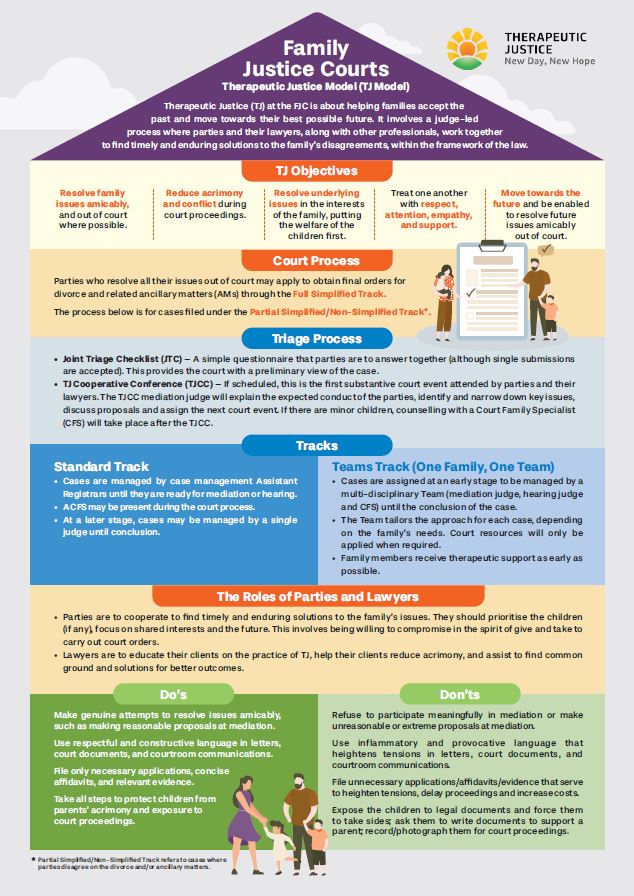Family Justice Courts Therapeutic Justice Model (TJ Model)
The Therapeutic Justice Model (TJ Model) was launched on 21 October 2024 by Chief Justice Sundaresh Menon. It seeks to provide a framework within which all participants in the family justice ecosystem can work together to better serve the needs of families and children.

- The TJ Model (PDF, 434 KB)
- The TJ Model (Abridged Version) (PDF, 76 KB)
- The TJ Model Practice Directions
- Part IIIA, Family Justice Courts Practice Directions 2015. (PDF, 218 KB)
- Part 7I, Family Justice Courts Practice Directions 2024. (PDF, 220 KB)
About Therapeutic Justice Model
Taking ownership to resolve family disputes
Court users in family disputes are encouraged to take ownership of their decisions, work closely with other family members to resolve issues and move on together to better times.
Anyone faced with family disputes can benefit from applying TJ principles as they seek to bring about hope and new beginnings.
How you can help to diffuse and resolve family disputes
- Let’s focus on their future: We can put children first
Children are the future. Even in challenging times, the well-being and best interests of children must remain the priority. - Let’s build bridges, not barriers: We can make lasting solutions
Building connections and relationships require time and consistent effort. It takes everyone involved to work together to solve the problem and make lasting solutions. - Let’s find solutions: We can solve problems
It is often said that there is a solution to every problem. Families in disputes should not allow themselves to get sidetracked as it is counterproductive. Focus on what is important – the way forward to a more hopeful future for the family. - Let’s respect and understand one another: We can work together
Respect goes both ways. When families in disputes engage each other in solving problems, they work as a team, playing different roles but sharing a common goal. Respect and understand each party’s views – acknowledge different ideas and work together to select the option with the best outcome possible.
- Let’s find peace in the process: We can choose to be calm
Keeping our composure and staying calm is the first step to a clearer solution and a brighter way forward. Being angry complicates matters and makes any issue more challenging to resolve.
- Let’s see the big picture: We can build better tomorrows
At times, it is easy to get caught up in the details and lose sight of the bigger picture. It is important to never lose sight of the big picture - a better tomorrow for the family.
Similar to a jigsaw puzzle, families in disputes may piece the 6 steps above for a roadmap to improve relationships going forward.
Resources
- Therapeutic Justice Poster(PDF, 10,177 KB)









